

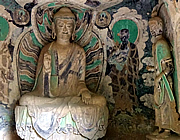
The grottoes of Bingling date back to the Western Qin Dynasty, 1600 years ago, and have been developed almost continuously since that time. Hundreds of Buddhas and Bodhisattvas in niches and grottoes, and an enormous Buddha carved into the cliff, stand testament to the endurance of Buddhism in this region.
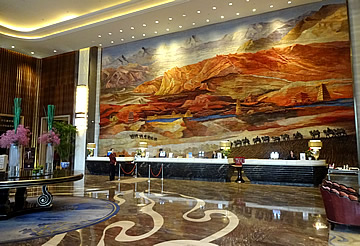
From Zhangye we took the train to Lanzhou where we stayed in a very good hotel, the Wanda Vista, with excellent food. We'd had two weeks of Chinese dishes and we were really pining for some western food - the fish and chips were wonderful, and breakfast was pretty good too, especially the gorgeous cherries.
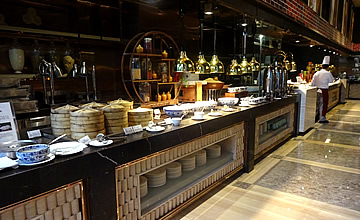
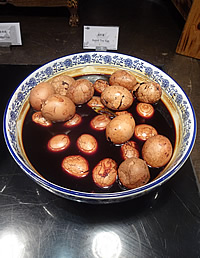
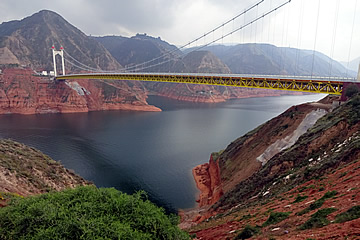
We set off at 9:30 for Bingling. It was a relatively easy two and a quarter hours with a break at an impressive suspension bridge where a Tibetan monk was very keen to take Andrew's photograph!
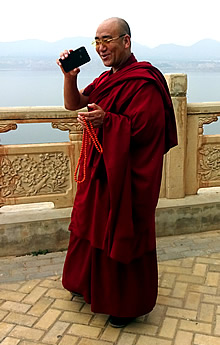
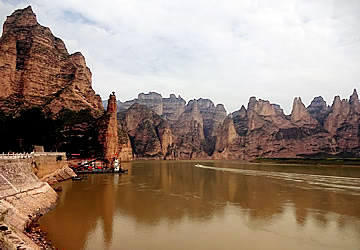
We arrived at the embarkation point at the Linjiaxia Reservoir on the Yellow River. We were to be taken by a small boat, very low in the water, up river to Bingling.
The gorge at Bingling is very impressive, the high pinnacled rocks surround the area where we docked.
This is the Danxia Landform, red sandstone from the cretaceous period weathered into a forest of pinnacles.

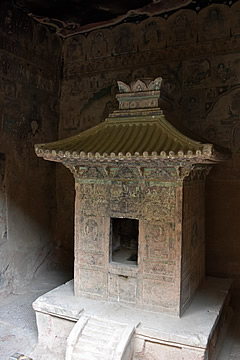
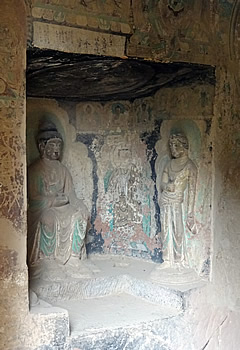
The grottoes were begun in the time of the Western Qin Dynasty, which ruled in what is now Gansu province of south western China off and on from 385 to 431. It was developed over the centuries through many dynasties right up to the final Qing Dynasty which ruled from 1644 to 1912. There are a total of 185 grottoes and niches with 776 statues and 912 square metres of frescoes.
The caves are all carved into the east-facing wall of a ravine off the Yellow River, so it is advisable to visit in the morning when they are illuminated - flash is not allowed though thankfully we could otherwise take photographs which was great, this was the first of the three Thousand Buddha Cave systems we had visited where it was allowed.
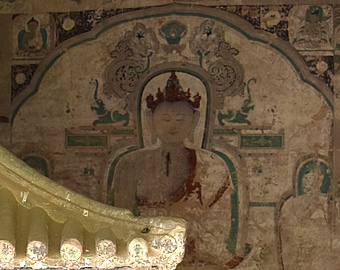
The first cave we visited was "Grotto 3 - The Glorious Age of Tang Dynasty (713-766)" as the information sign has it. It is a flat-ceilinged cube with an upper and lower niche on the south wall.
A Tang Dynasty style tower with a carved roof stands in the centre.
The murals were repainted during the Ming Dynasty, 1368-1644.
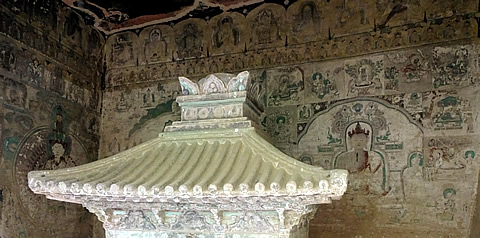
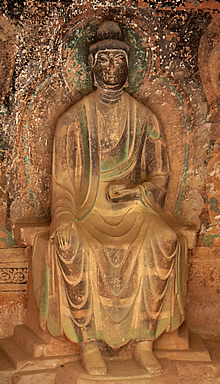
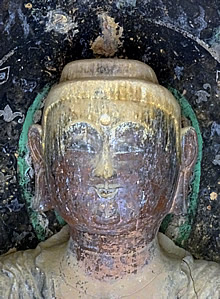
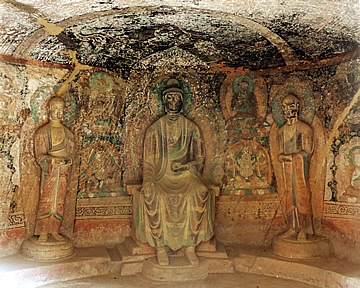
Then to "Grotto 4 Early Tang Dynasty 318-712" and "Grotto 6 The Northern Zhou Dynasty 557-581", both with fine Buddhas and bodhisattvas.
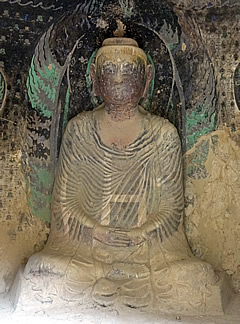
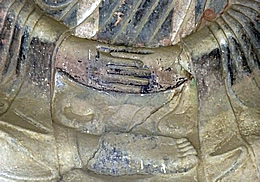
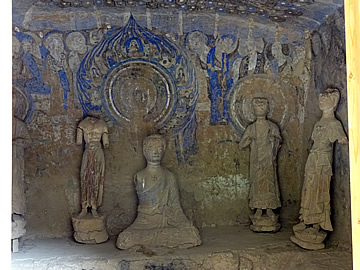
Grotto 8, Sui Dynasty 581-618, holds a Buddha with two Disciples and two Bodhisattvas. The statues and murals in this grotto tell the story of "The Debate between Manjusri and Vimalakirti." Vimalakirti was an enlightened layman, whose teachings are the subject of the Vimalakirti Sutra. Manjusri was associated with wisdom and both were important Bodhisattvas of Mahayana Buddhism.
The collars of the bodhisattvas in attendance are a linked pearl pattern of a central Asian Persian style, and Uighur scripts can be seen, all of which show the multi-ethnic contact afforded by the proximity of the Silk Road.
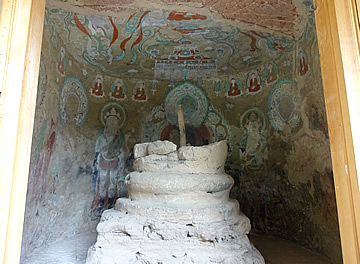
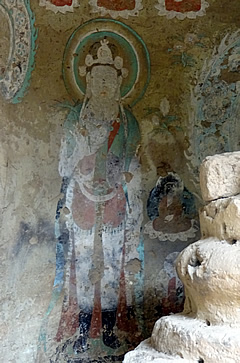
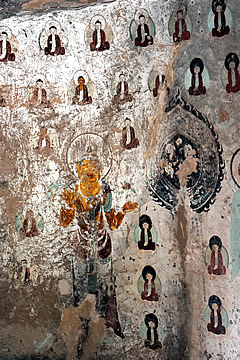
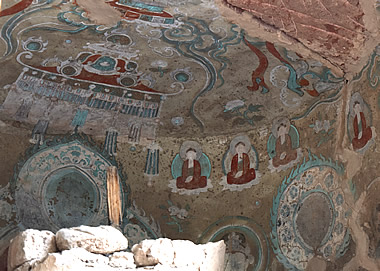
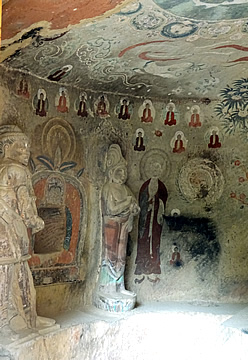
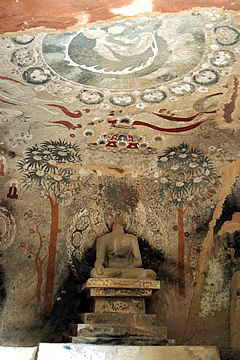
Originally Grotto 10, Tang Dynasty (618-907), held a Buddha, two Disciples, two Bodhisattvas and two Heavenly Kings but the statues of the Disciples have been removed to an exhibition hall. The Heavenly Kings wear armour.
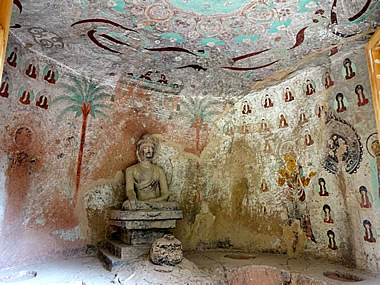
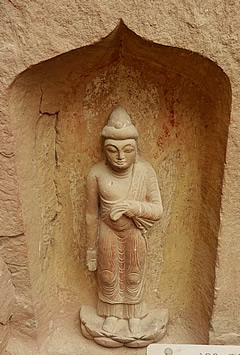
Grotto 11 also dates from the Tang Dynasty, including a period when the Tibetan Tubo occupied the area. The murals show features of Tubo artistic technique such as the diaphanous drapery revealing the legs of the bodhisattvas.
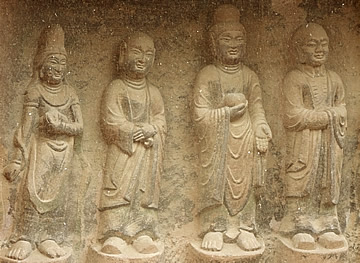
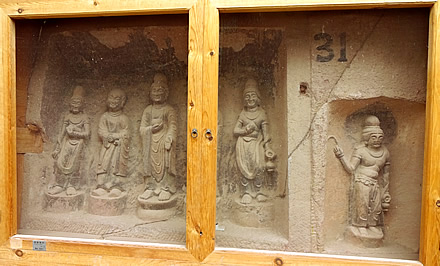
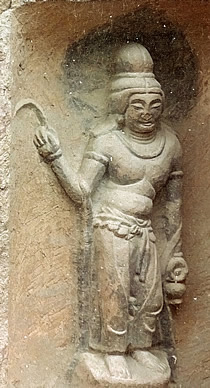
There are hundreds of carvings in niches on the rock wall of the ravine. Many of the best-preserved are protected by wire mesh. Niches 17-47 all date from the "Glorious Age of Tang Dynasty (618-907)" and hold a total of 24 Buddha statues, 46 Bodhisattvas, 16 Disciples, 4 Heavenly Kings, and 4 Yakshas, all of which were completed during the period from the reign of Emperor Gaozong of Tang to that of Empress Wu Zetian (650-705).
Many of the faces look very individual, as though these are real people.
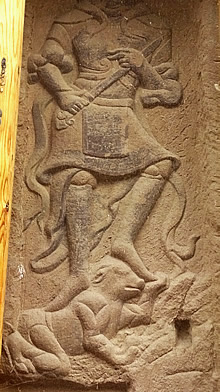
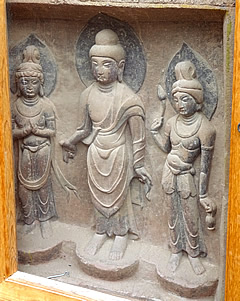
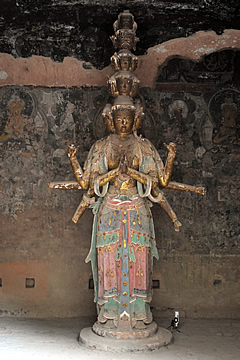
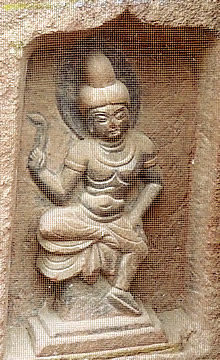
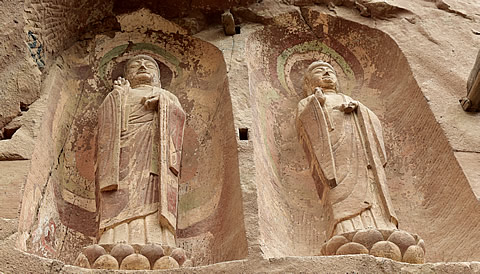
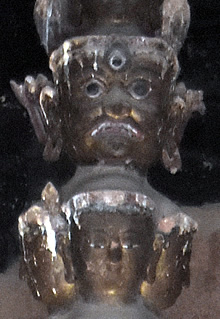
Grotto 70 contains a statue of Avolokitesvara, in wood and clay, with 8 arms and 11 faces arranged vertically in 5 layers. The top two heads have only one face each, looking rather fierce, the lower three each have three faces with more benign expressions and downcast eyes. It is a typical Ming Dynasty Tibetan Buddhism sculpture of the compassionate Bodhisattva who delays becoming a Buddha to help others. The murals in Grotto 70 include Mandala Maps, the eighteen Disciples of the Buddha, and Sutra paintings.
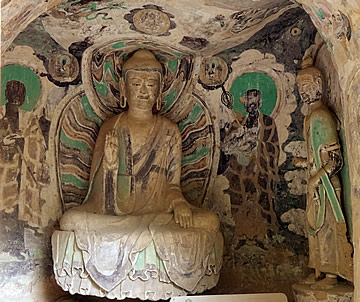
There is a seated clay Buddha and two Bodhisattvas in Grotto 82. The murals exist in two layers, from the Zhou and Ming Dynasties. On the ceiling and the entrance the Zhou Dynasty paintings have been exposed, with flying Apsaras and floating clouds. The Ming Dynasty repainting includes images of Zongkapa, the founder of the Gelug Sect of TIbetan Buddhism, in the upper part of the back wall.
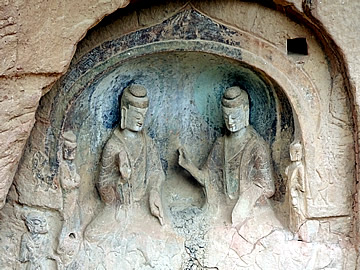
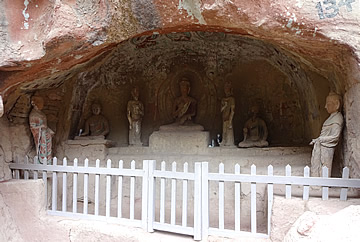
The shallow dome of Niche 125 shelters Buddha Shakyamuni and Buddha Prabhutaratna with two Bodhisattvas. Outside the niche two mallas (men of unusual strength) stand guard. The beautiful pointed arch ends in dragon heads, their bodies seeming to curve up and around to form the arch.
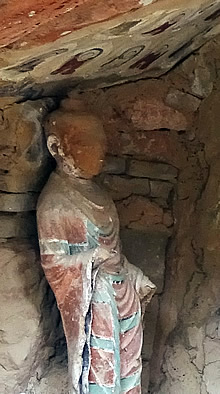 Standing Buddha in Grotto 134 and part of the ceiling painted with a Thousand Buddhas.
Standing Buddha in Grotto 134 and part of the ceiling painted with a Thousand Buddhas.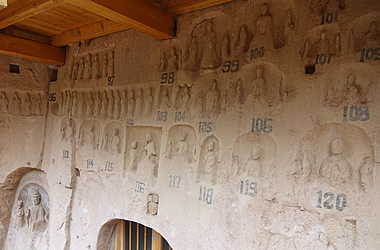
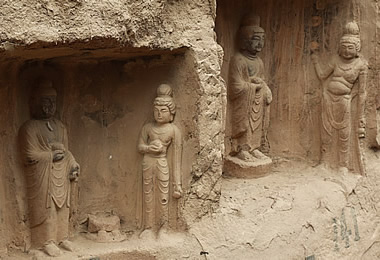
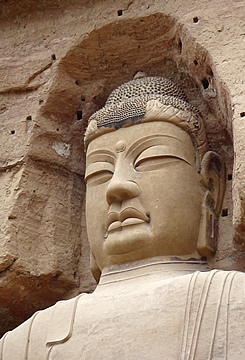
In Grotto 134 the central Buddha is flanked by two Bodhisattvas and there are two more sitting and two standing Buddhas. The dome was painted with "thousands" of Buddhas.
A 27m seated Buddha is carved into the cliff at a point where a bridge crosses the ravine. It is best seen from the bridge or the other side of the ravine - very impressive. It was probably created during the Tang Dynasty, 1200 years ago.
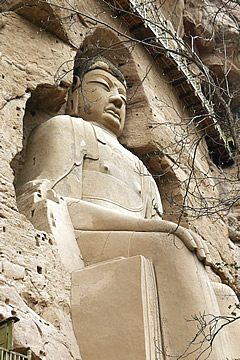
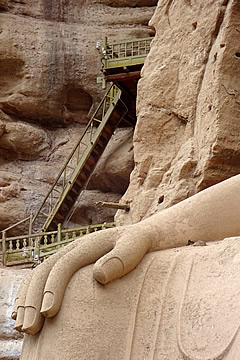
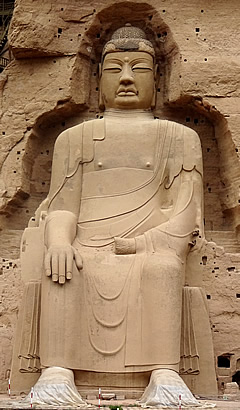
The carving of the giant Buddha still looks very crisp, not sure if it has recently been renovated, but I would guess it has.
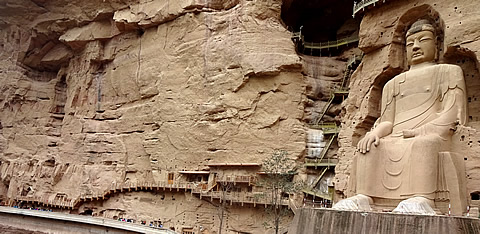
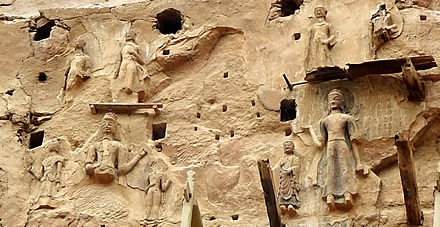
We made our way back on the east side of the ravine. Here, in Grotto 16 lies an 8.64m long reclining Buddha dating from the Northern Wei Dynasty. It was originally located in the Reclining Buddha Temple 15m below the middle of the caves and niches group but was moved in 1967 when protective levees were built.

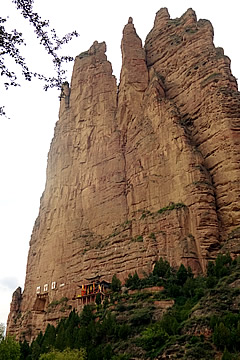
At this time it was discovered that the Buddha had been somewhat recarved during both the Tang and Ming Dynasties. It was restored to the original Wei Dynasty statue.
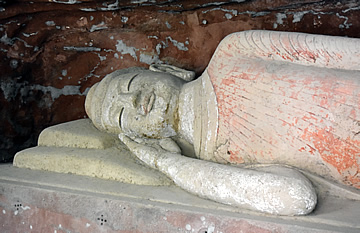
We had a really bad lunch here, a real rip-off and probably the worst meal we've had in China, on a floating "restaurant" catering for tourists. There was nothing else apart from women at the waterside cooking potatoes and corn. Our guide bought some corn and shared it but it was undercooked.
At least the view of the pinnacles of rock all around the river was a good one! We enjoyed dinner at the hotel even more that evening!
